Synthesis and Characterization of New Copper(II) Coordination Compounds with Methylammonium Cations
Abstract
:1. Introduction
2. Experimental Setup
2.1. Synthesis of (MeNH3)4[Cu2Ac4Cl2]Cl2·2H2O (1)
2.2. Synthesis of (NH2Me2)2[Cu2Ac4Cl2] (2)
2.3. Synthesis of (NH2Me2)4[Cu2Ac4Cl2]Cl2·2H2O (3)
2.4. Synthesis of (NMe4)5n[Cu2Ac4Cl]nCl4n·4nH2O (4)
2.5. X-ray Crystallography
2.6. IR Spectroscopy
2.7. Magnetic Measurements
2.8. Thermal Analysis and X-ray Powder Diffraction
3. Results and Discussion
3.1. Description of Structures
3.2. Thermal Analysis
3.3. IR Spectra
3.4. Magnetic Properties
4. Conclusions
Supplementary Materials
Author Contributions
Funding
Data Availability Statement
Conflicts of Interest
References
- Mączka, M.; Ptak, M.; Gągor, A.; Stefańska, D.; Zaręba, J.K.; Sieradzki, A. Methylhydrazinium Lead Bromide: Noncentrosymmetric Three-Dimensional Perovskite with Exceptionally Large Framework Distortion and Green Photoluminescence. Chem. Mater. 2020, 32, 1667–1673. [Google Scholar] [CrossRef]
- Fabini, D.H.; Labram, J.G.; Lehner, A.J.; Bechtel, J.S.; Evans, H.A.; Van der Ven, A.; Wudl, F.; Chabinyc, M.L.; Seshadri, R. Main-Group Halide Semiconductors Derived from Perovskite: Distinguishing Chemical, Structural, and Electronic Aspects. Inorg. Chem. 2017, 56, 11–25. [Google Scholar] [CrossRef] [PubMed]
- Dionigi, C.; Goudjil, M.; Ruani, G.; Bindi, L. The Effect of Short Chain Carboxylic Acids as Additives on the Crystallization of Methylammonium Lead Triiodide (MAPI). Inorganics 2022, 10, 201. [Google Scholar] [CrossRef]
- Oku, T.; Uchiya, S.; Okumura, R.; Suzuki, A.; Ono, I.; Fukunishi, S.; Tachikawa, T.; Hasegawa, T. Effects of Co-Addition of Guanidinium and Cesium to CH3NH3PbI3 Perovskite Solar Cells. Inorganics 2023, 11, 273. [Google Scholar] [CrossRef]
- Kubicki, D.J.; Prochowicz, D.; Salager, E.; Rakhmatullin, A.; Grey, C.P.; Emsley, L.; Stranks, S.D. Local Structure and Dynamics in Methylammonium, Formamidinium, and Cesium Tin(II) Mixed-Halide Perovskites from 119Sn Solid-State NMR. J. Am. Chem. Soc. 2020, 142, 7813–7826. [Google Scholar] [CrossRef]
- Gray, M.B.; Holzapfel, N.P.; Liu, T.; Da Cruz Pinha Barbosa, V.; Harvey, N.P.; Woodward, P.M. Synthesis, crystal chemistry, and optical properties of two methylammonium silver halides: CH3NH3AgBr2 and CH3NH3Ag2I3. J. Mater. Chem. C 2021, 9, 9251–9259. [Google Scholar] [CrossRef]
- Murasugi, H.; Kumagai, S.; Iguchi, H.; Yamashita, M.; Takaishi, S. Organic–Inorganic Hybrid Gold Halide Perovskites: Structural Diversity through Cation Size. Chem. Eur. J. 2019, 25, 9885–9891. [Google Scholar] [CrossRef]
- Boča, M.; Svoboda, I.; Renz, F.; Fuess, H. Poly[methylammonium tris(μ2-formato-κ2O:O’)cobalt(II)]. Acta Crystallogr. C 2004, 60, m631–m633. [Google Scholar] [CrossRef]
- Gerasimenko, A.V.; Davidovich, R.L.; Logvinova, V.B. Crystal structures of layered zirconium pentafluorides of methylammonium, glycinium, and β-alanine. J. Struct. Chem. 2011, 52, 524–530. [Google Scholar] [CrossRef]
- Bujak, M.; Angel, R.J. Single crystal X-ray diffraction studies on [(CH3)nNH4–n]3[Sb2Cl9] (n = 2, 3) chloroantimonates(III) in their low-temperature ferroelectric phases—Structures and phase transitions. J. Solid State Chem. 2005, 178, 2237–2246. [Google Scholar] [CrossRef]
- Conry, R.R. Copper: Inorganic & Coordination Chemistry. Based in part on the article Copper: Inorganic & Coordination Chemistry by Rebecca R. Conry & Kenneth D. Karlin which appeared in the Encyclopedia of Inorganic Chemistry, First Edition. In Encyclopedia of Inorganic and Bioinorganic Chemistry; Scott, R.A., Ed.; Wiley: Hoboken, NJ, USA, 2011. [Google Scholar] [CrossRef]
- Steinhauser, G.; Karaghiosoff, K.; Klapötke, T.M. Synthesis and Crystal Structure of (CH3NH3)2[Cu(NO3)4]: A Rare Example of a Tetranitratocuprate(II) with a Light Cation of the Type M2[Cu(NO3)4]. Z. Anorg. Allg. Chem. 2008, 634, 892–894. [Google Scholar] [CrossRef]
- Afonin, E.G.; Aleksandrov, G.G.; Sergienko, V.S. Synthesis and properties of protonated methylammonium bis(1-hydroxyethane-1,1-diphosphonato)cuprates(II).: Crystal structure of (CH3NH3)2[Cu(H2O)(H2L)2]·H2O. Russ. J. Coord. Chem. 1999, 25, 863–869. [Google Scholar]
- Martin, J.D.; Yang, J.; Dattelbaum, A.M. Templated Synthesis of Cuprous Chloride Networks: Synthesis and Characterization of [Hpy]Cu3Cl6 and {[H3NMe]Cl}[H3NMe]2Cu9Cl16. Chem. Mater. 2001, 13, 392–399. [Google Scholar] [CrossRef]
- Groeneveld, B.G.H.M.; Duim, H.; Kahmann, S.; De Luca, O.; Tekelenburg, E.K.; Kamminga, M.E.; Protesescu, L.; Portale, G.; Blake, G.R.; Rudolf, P.; et al. Photochromism in Ruddlesden–Popper copper-based perovskites: A light-induced change of coordination number at the surface. J. Mater. Chem. C 2020, 8, 15377. [Google Scholar] [CrossRef]
- Lu, J.-L.; Zhang, D.-S.; Li, L.; Liu, B.P. Bis(dimethylammonium) bis(pyridine-2,5-dicarboxylato)copper(II). Acta Crystallogr. E 2006, 62, m3321–m3322. [Google Scholar] [CrossRef]
- Demir, S.; Çepni, H.M.; Hołyńska, M.; Kavanoz, M. A tetranuclear copper (II) complex with pyrazole-3,5-dicarboxylate ligands: Synthesis, characterization and electrochemical properties. Z. Naturforsch. B 2016, 71, 305–310. [Google Scholar] [CrossRef]
- Burrows, A.D.; Mahon, M.F.; Sebestyen, V.M.; Lan, Y.; Powell, A.K. Synthesis, Structures, And Magnetic Behavior of New Anionic Copper(II) Sulfate Aggregates and Chains. Inorg. Chem. 2012, 51, 10983–10989. [Google Scholar] [CrossRef]
- Stone, M.B.; Tian, W.; Granroth, G.E.; Lumdsen, M.D.; Chung, J.-H.; Mandrus, D.G.; Nagler, S.E. Spin dynamics of the low-dimensional magnet (CH3)2NH2CuCl3. Physica B 2006, 385–386, 438–440. [Google Scholar] [CrossRef]
- Kirpichnikova, L.F.; Pietraszko, A.; Bednarski, W.; Waplak, S.; Sheleg, A.U. Crystal Structure and Phase Transitions in the New Crystals of [(CH3)2NH2]2CuCl4[(CH3)2NH2]Cl. Crystallogr. Rep. 2004, 49, 92–100. [Google Scholar] [CrossRef]
- Awwadi, F.; Willett, R.D.; Twamley, B.; Shneider, R.; Landee, C.P. Strong Rail Spin 1/2 Antiferromagnetic Ladder Systems: (Dimethylammonium)(3,5-Dimethylpyridinium)CuX4, X = Cl, Br. Inorg. Chem. 2008, 47, 9327–9332. [Google Scholar] [CrossRef]
- Salimi, S.; Akhbari, K.; Farhia, S.M.F.; White, J.M. Sonochemical synthesis and crystal structure of copper(II)-based biodegradable antibacterial scaffold. J. Mol. Struct. 2022, 1267, 133521. [Google Scholar] [CrossRef]
- Gupta, K.; Biswas, B.; Mallick, S.; Rizzoli, C.; Saha, S.K.; Roy, U.K.; Saha, R. Insight on the presence of dimethylammonium cation within anionic metal-organic supramolecular host: Structural, Hirshfeld surface, optical and theoretical analysis. J. Coord. Chem. 2023, 76, 1553–1566. [Google Scholar] [CrossRef]
- Powell, R.E.; Lees, M.R.; Tizzard, G.J.; Coles, S.J.; Yuan, Q.; Van Koningsbruggen, P.J. FeIII in the high-spin state in dimethylammonium bis [3-ethoxysalicylaldehyde thiosemicarbazonato(2–)-κ3O2,N1,S]ferrate(III). Acta Crystallogr. C 2023, 79, 18–24. [Google Scholar] [CrossRef] [PubMed]
- Abdelhadi, A.B.; Rodriguez-Sánchez, S.; Ouarsal, R.; Saadi, M.; El Ammari, L.; Morley, N.; El Bali, B.; Gómez-Torres, Ó.; Lachkar, M.; Douhal, A. Synthesis, characterization, and magnetic and antibacterial properties of a novel iron(iii) complex (CH3)2NH2[Fe(phen)Cl4]. Mater. Adv. 2024, 5, 3058–3066. [Google Scholar] [CrossRef]
- Peksa, P.; Nowok, A.; Formalik, F.; Zaręba, J.K.; Trzimiel, J.; Gągor, A.; Mączka, M.; Sieradzki, A. More complex than originally thought: Revisiting the origins of the relaxation processes in dimethylammonium zinc formate. J. Mater. Chem. C 2022, 10, 6866–6877. [Google Scholar] [CrossRef]
- Sharif, S.; Saeed, M.; Dege, N.; Bano, R.; Gilani, M.A.; Şahin, O.; Ahmad, S.; Ch, A.R. Solvothermal synthesis, crystal structure, thermal, magnetic properties and DFT computations of a Ytterbium(III) complex derived from pyridine-2,6-dicarboxylic acid. J. Mol. Struct. 2022, 1260, 132877. [Google Scholar] [CrossRef]
- Ivanova, A.A.; Gontcharenko, V.E.; Lunev, A.M.; Sidoruk, A.; Arkhipov, I.A.; Taydakov, I.V.; Belousov, Y.A. New Carboxylate Anionic Sm-MOF: Synthesis, Structure and Effect of the Isomorphic Substitution of Sm3+ with Gd3+ and Tb3+ Ions on the Luminescent Properties. Inorganics 2022, 10, 104. [Google Scholar] [CrossRef]
- Mautner, F.A.; Hanna, S.; Cortés, R.; Lezama, L.; Gotzone Barandinka, M.; Rojo, T. Crystal Structure and Spectroscopic and Magnetic Properties of the Manganese(II) and Copper(II) Azido-Tetramethylammonium Systems. Inorg. Chem. 1999, 38, 4647–4652. [Google Scholar] [CrossRef]
- Liu, X.; Guo, G.-C.; Wu, A.-Q.; Ci, L.-Z.; Huang, J.-S. Two Halogeno(cyano)cuprates with Long-Lived and Strong Luminescence. Inorg. Chem. 2005, 44, 4282–4286. [Google Scholar] [CrossRef]
- Jalilian, E.; Lidin, S. Size matters-sometimes. The [CuxIy](y−x)−(NR4)+(y−x) systems. CrystEngComm 2011, 13, 5730–5736. [Google Scholar] [CrossRef]
- Vilela, R.S.; Oliveira, T.L.; Martins, F.T.; Ellena, J.A.; Lloret, F.; Julve, M.; Cangussu, D. Synthesis, crystal structure and magnetic properties of the helical oxalate-bridged copper(II) chain {[(CH3)4N]2[Cu(C2O4)2]·H2O}n. Comptes Rendus Chim. 2012, 15, 856–865. [Google Scholar] [CrossRef]
- Fernandes, T.S.; Vilela, R.S.; Valdo, A.K.; Martins, F.T.; García-España, E.; Inclán, M.; Cano, J.; Lloret, F.; Julve, M.; Stumpf, H.O.; et al. Dicopper(II) Metallacyclophanes with N,N′-2,6-Pyridinebis(oxamate): Solution Study, Synthesis, Crystal Structures, and Magnetic Properties. Inorg. Chem. 2016, 55, 2390–2401. [Google Scholar] [CrossRef]
- Grancha, T.; Ferrando-Soria, J.; Armentano, D.; Pardo, E. Synthesis of a chiral rod-like metal–organic framework from a preformed amino acid-based hexanuclear wheel. J. Coord. Chem. 2019, 72, 1204–1221. [Google Scholar] [CrossRef]
- Nicholas, A.D.; Bullard, R.M.; Wheaton, A.M.; Streep, M.; Nicholas, V.A.; Pike, R.D.; Patterson, H.H. Synthesis and Luminescence of Optical Memory Active Tetramethylammonium Cyanocuprate(I) 3D Networks. Materials 2019, 12, 1211. [Google Scholar] [CrossRef]
- Hassan, N.; Nagaraja, S.; Saha, S.; Tarafder, K.; Ballav, N. Excitonic cuprophilic interactions in one-dimensional hybrid organic–inorganic crystals. Chem. Sci. 2024, 15, 4075–4085. [Google Scholar] [CrossRef] [PubMed]
- Koziskova, J.; Hahn, F.; Richter, J.; Kožišek, J. Comparison of different absorption corrections on the model structure of tetrakis(μ2-acetato)-diaqua-di-copper(II). Acta Chim. Slovaca 2016, 9, 136–140. [Google Scholar] [CrossRef]
- Rigaku Oxford Diffraction. CrysAlisPro, Version 1.171.39.46e; Rigaku Oxford Diffraction: The Woodlands, TX, USA, 2018.
- Altomare, A.; Burla, M.C.; Camalli, M.; Cascarano, G.L.; Giacovazzo, C.; Guagliardi, A.; Moliterni, A.G.G.; Polidori, G.; Spagna, R. SIR97: A new tool for crystal structure determination and refinement. J. Appl. Crystallogr. 1999, 32, 115–119. [Google Scholar] [CrossRef]
- Sheldrick, G.M. Crystal structure refinement with SHELXL. Acta Crystallogr. C 2015, 71, 3–8. [Google Scholar] [CrossRef]
- Farrugia, J.L. ORTEP-3 for Windows—A version of ORTEP-3 with a Graphical User Interface (GUI). J. Appl. Crystallogr. 1997, 30, 565. [Google Scholar] [CrossRef]
- Macrae, C.F.; Edgington, P.R.; McCabe, P.; Pidcock, E.; Shields, G.P.; Taylor, R.; Towler, M.; Van de Streek, J. Mercury: Visualization and analysis of crystal structures. J. Appl. Crystallogr. 2006, 39, 453–457. [Google Scholar] [CrossRef]
- Kahn, O. Molecular Magnetism; VCH Publishing: Weinheim, Germany; New York, NY, USA, 1993. [Google Scholar] [CrossRef]
- Bellamy, L.J. The Infrared Spectra of Complex Molecules, 3rd ed.; Chapman and Hall: London, UK, 1975. [Google Scholar] [CrossRef]
- Martini, D.; Pellei, M.; Pettinari, C.; Skelton, B.W.; White, A.H. Synthesis, spectroscopic and structural characterization of Cu(II) derivatives of tris(pyrazol-1-yl)methanes. Inorganica Chim. Acta 2002, 333, 72–82. [Google Scholar] [CrossRef]
- Vargová, Z.; Zenlenák, V.; Cisarová, I.; Györyová, K. Correlation of thermal and spectral properties of zinc(II) complexes of pyridinecarboxylic acids with their crystal structures. Thermochim. Acta 2004, 423, 149–157. [Google Scholar] [CrossRef]
- Ashcroft, N.W.; Mermin, N.D. Solid State Physics; Saunders College Publishing: Philadelphia, PA, USA, 1976. [Google Scholar]
- Chilton, N.F.; Anderson, R.P.; Turner, L.D.; Soncini, A.; Murray, K.S. PHI: A powerful new program for the analysis of anisotropic monomeric and exchange-coupled polynuclear d- and f-block complexes. J. Comput. Chem. 2013, 34, 1164–1175. [Google Scholar] [CrossRef] [PubMed]
- Mikuriya, M.; Yamakawa, C.; Tanabe, K.; Nukita, R.; Amabe, Y.; Yoshioka, D.; Mitsuhashi, R.; Tatehata, R.; Tanaka, H.; Handa, M.; et al. Copper(II) Carboxylates with 2,3,4-Trimethoxybenzoate and 2,4,6-Trimethoxybenzoate: Dinuclear Cu(II) Cluster and µ-Aqua-Bridged Cu(II) Chain Molecule. Magnetochemistry 2021, 7, 35. [Google Scholar] [CrossRef]
- Kristl, M.; Šturm, J.; Golobič, A.; Jagličić, Z.; Dojer, B. New copper(II) complexes with hydroxypyridines: Synthesis, structural, thermal, and magnetic properties. Inorganica Chim. Acta 2023, 556, 121670. [Google Scholar] [CrossRef]
- Kato, M.; Muto, Y. Factors affecting the magnetic properties of dimeric copper(II) complexes. Coord. Chem. Rev. 1988, 92, 45–83. [Google Scholar] [CrossRef]
- Kozlevčar, B.; Gamez, P.; De Gelder, R.; Jagličić, Z.; Strauch, P.; Kitanovski, N.; Reedijk, J. Counterion and Solvent Effects on the Primary Coordination Sphere of Copper(II) Bis(3,5-dimethylpyrazol-1-yl)acetic Acid Coordination Compounds. Eur. J. Inorg. Chem. 2011, 2011, 3650–3655. [Google Scholar] [CrossRef]
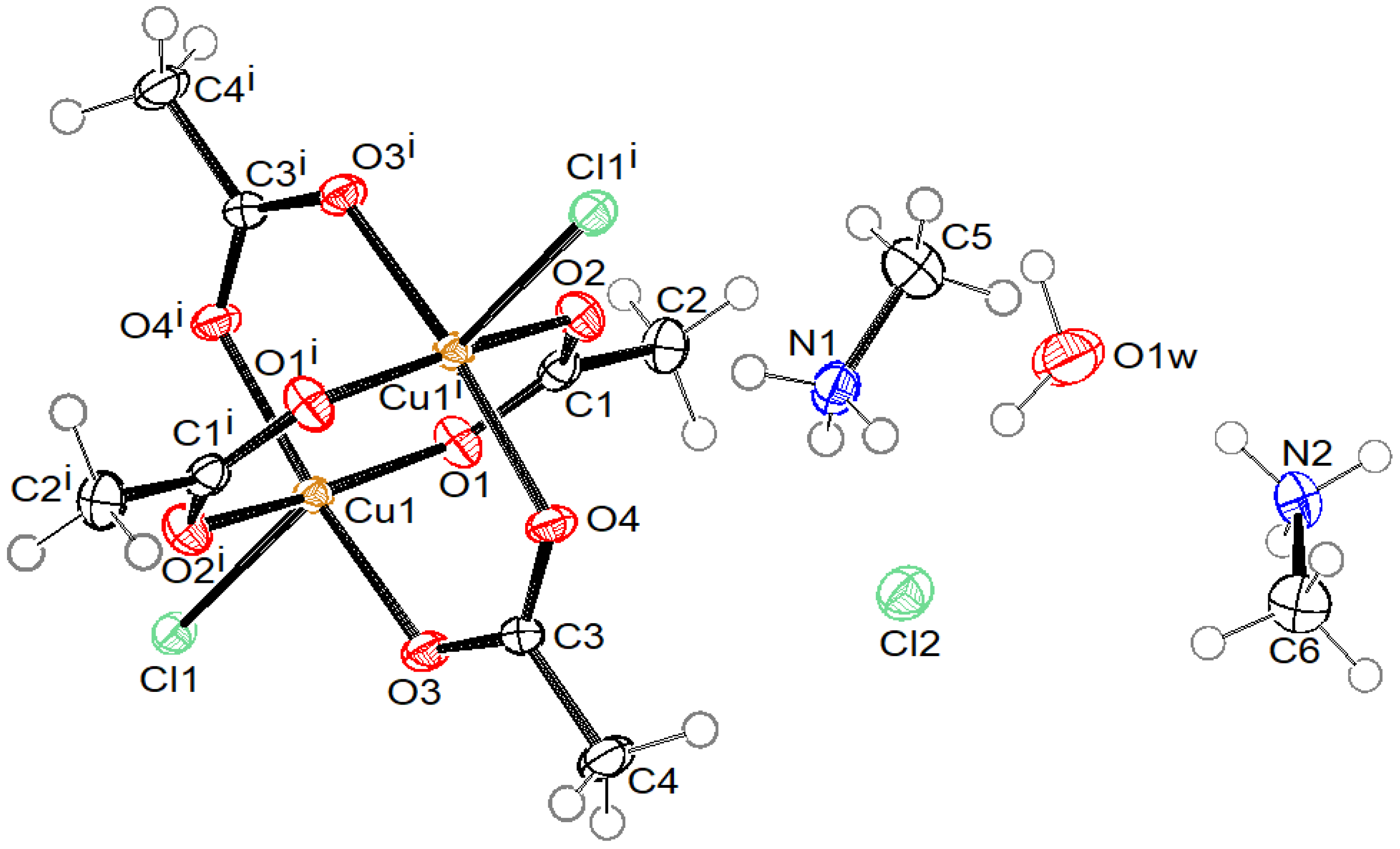

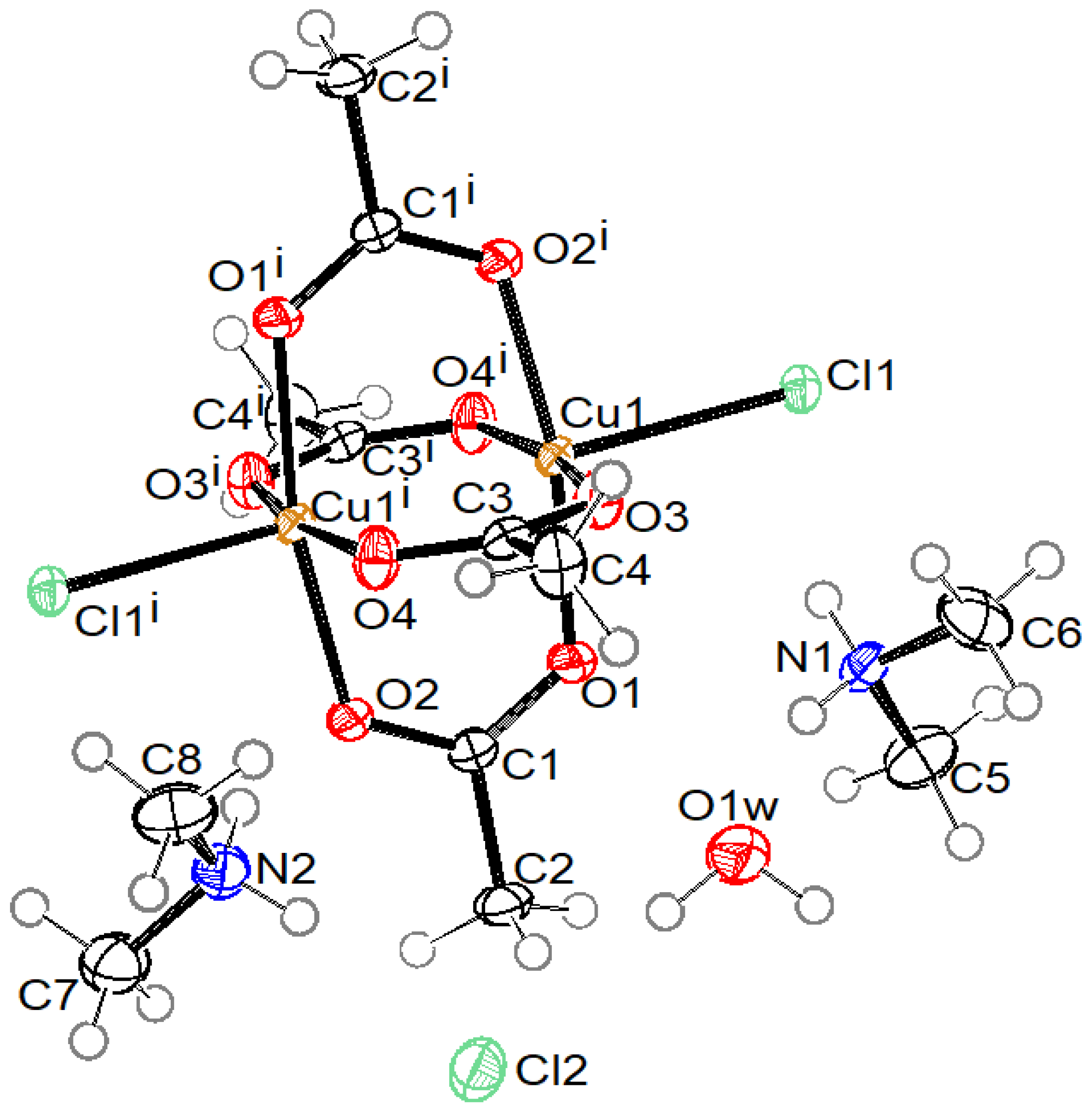

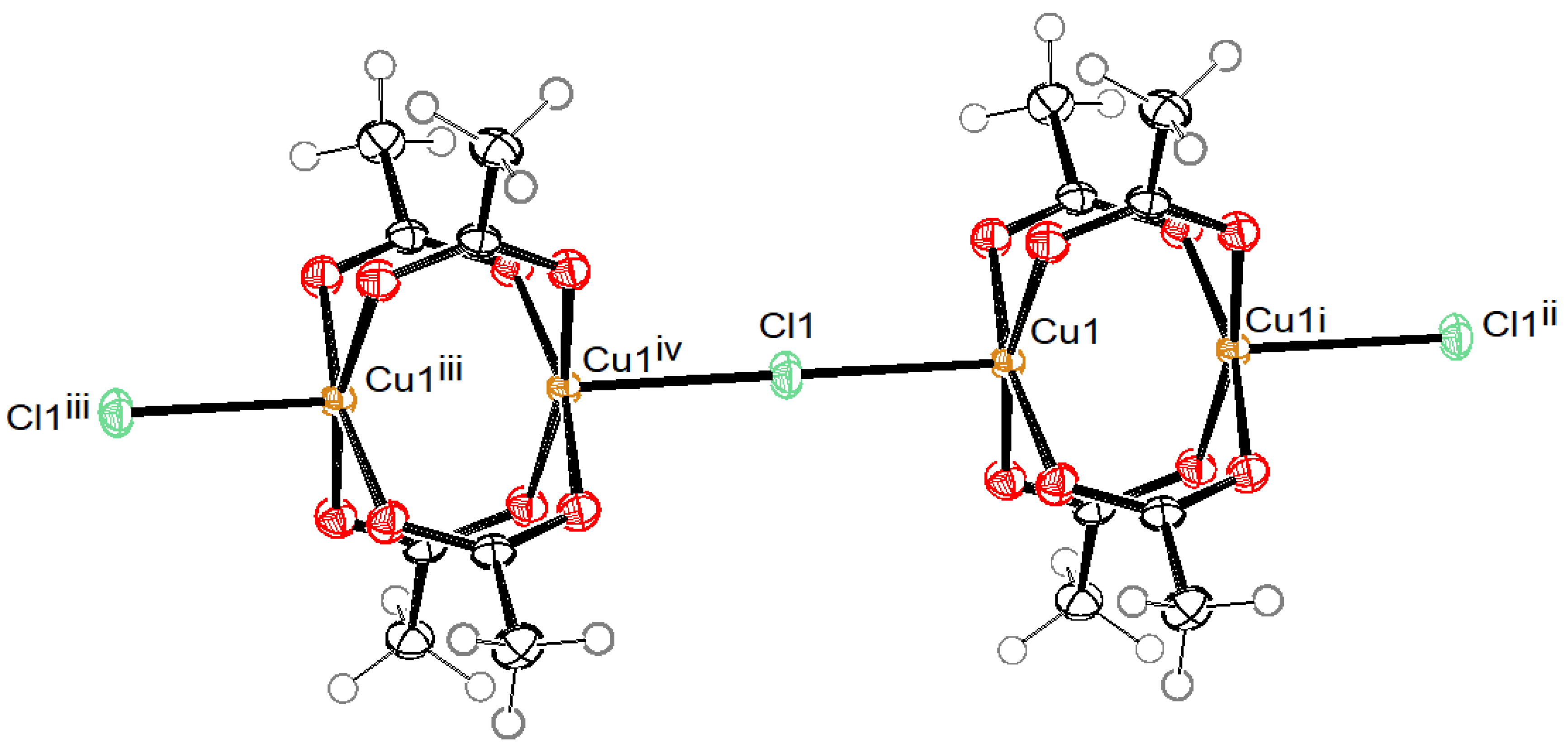

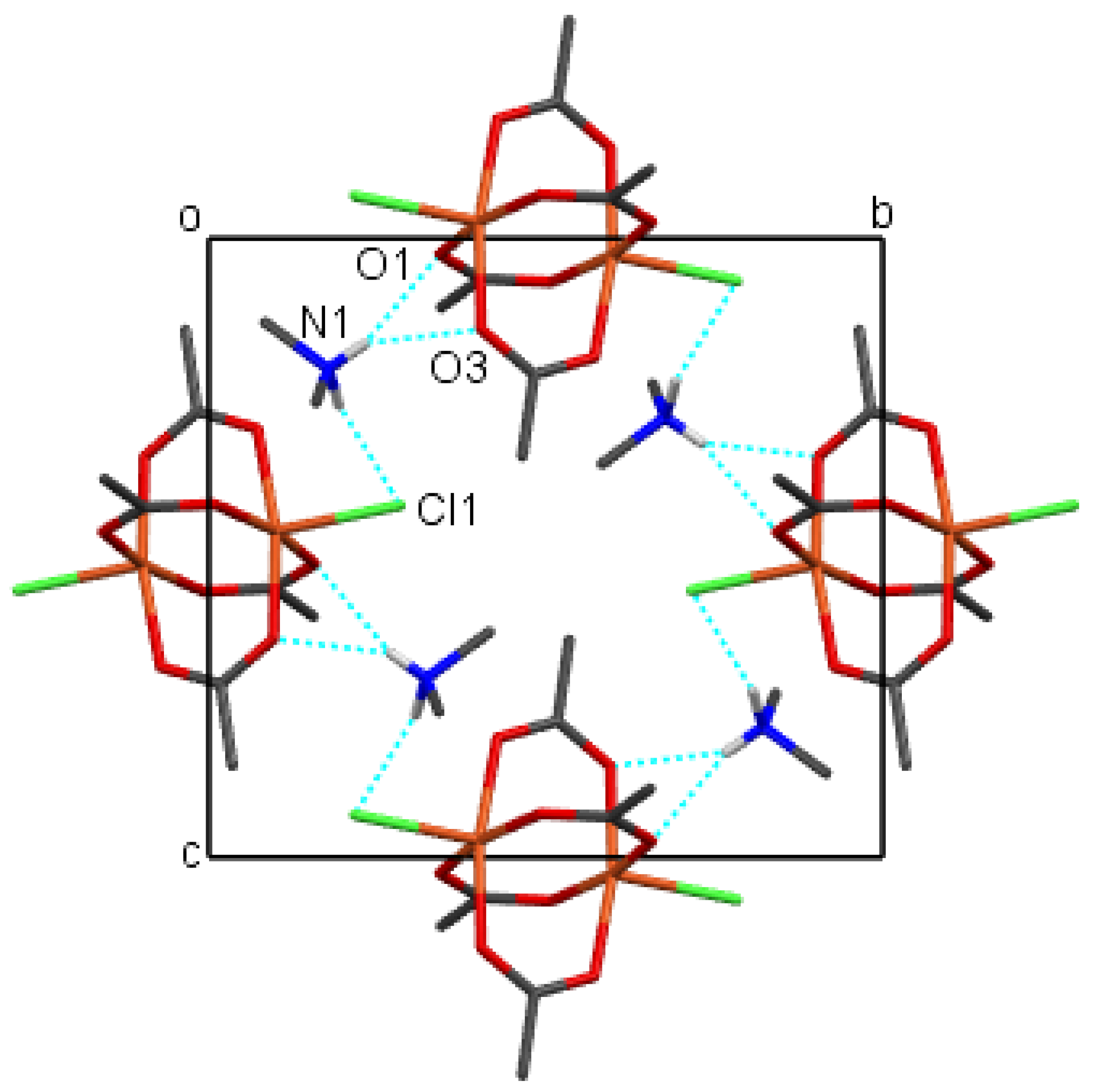
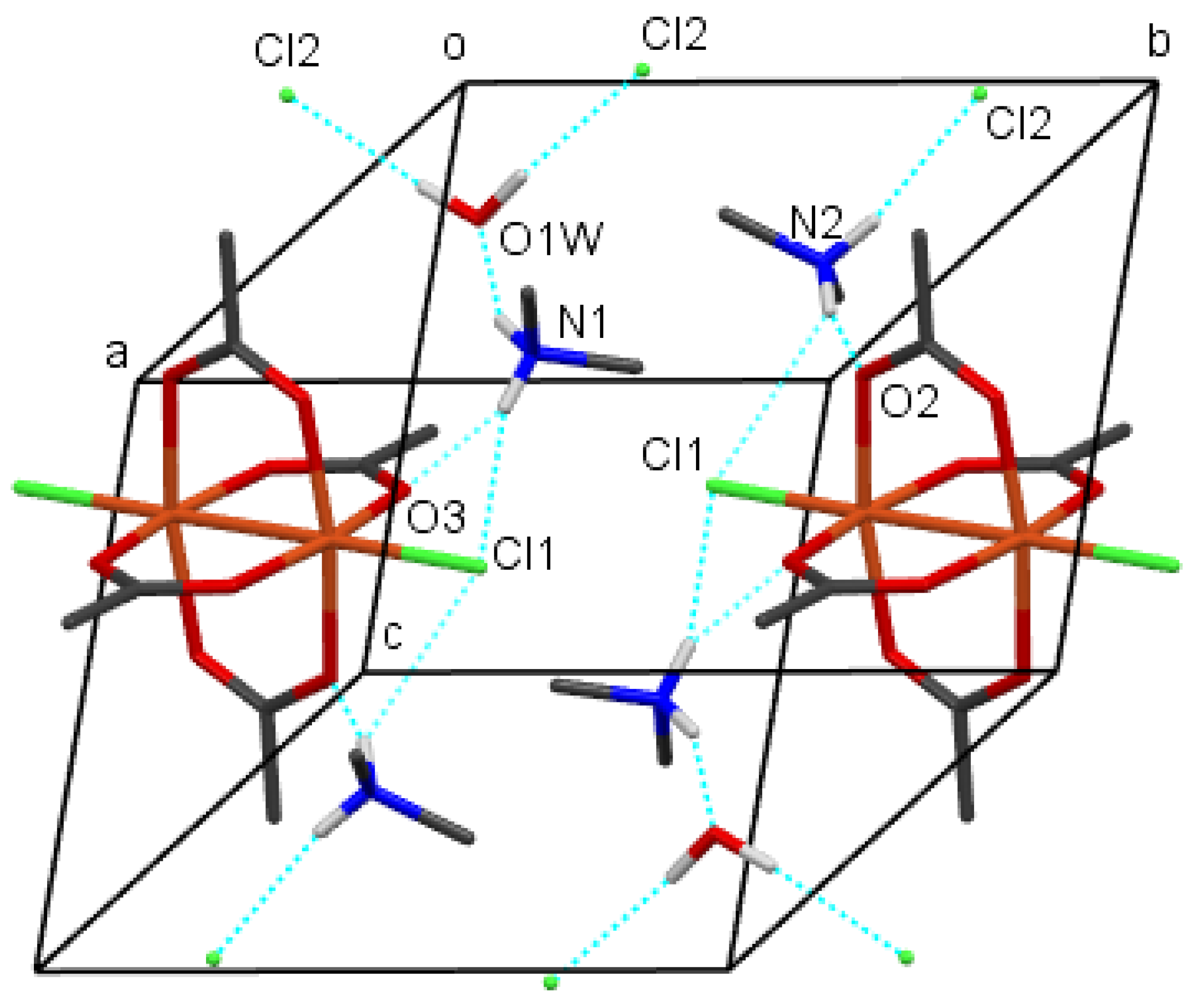
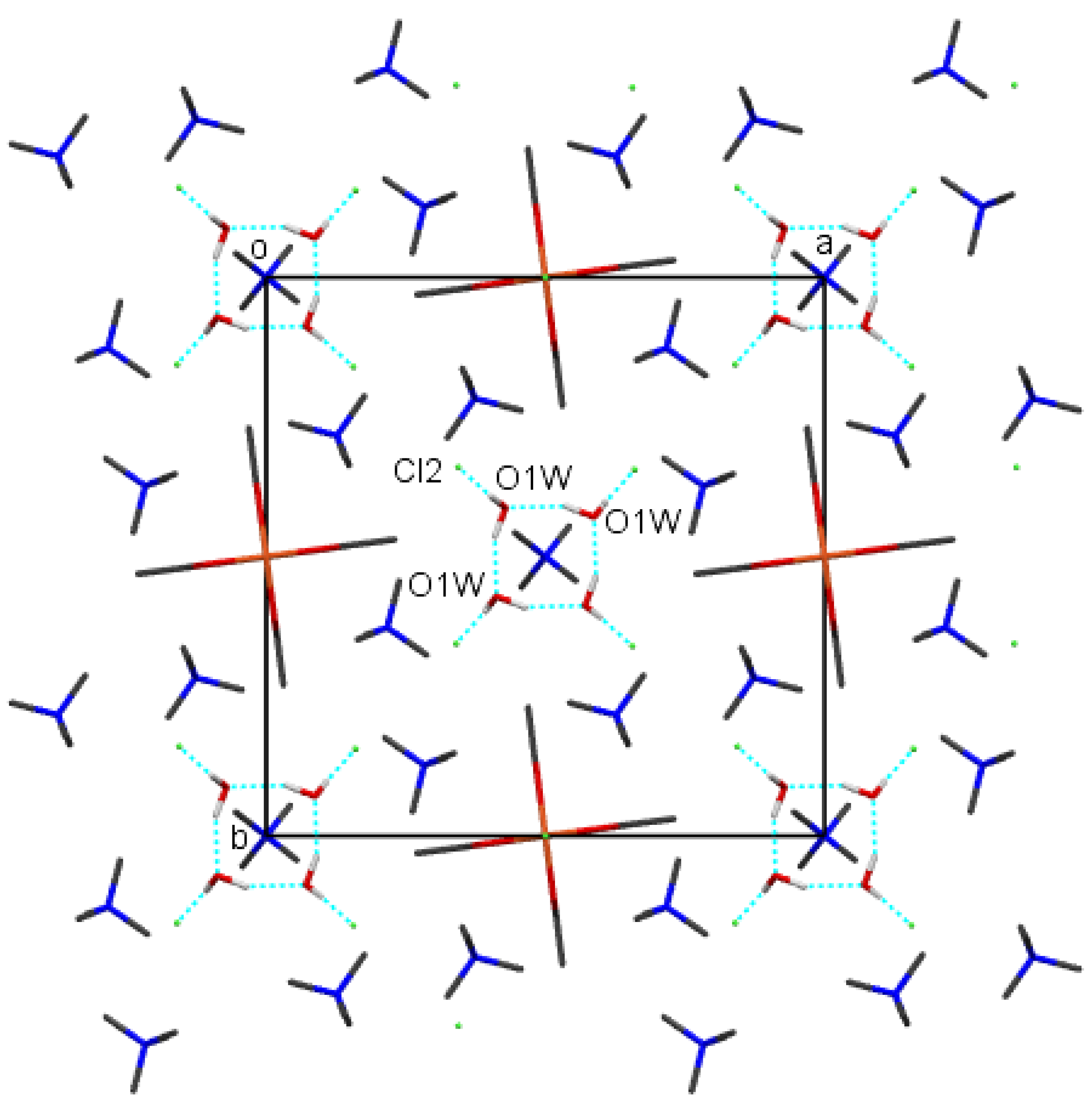
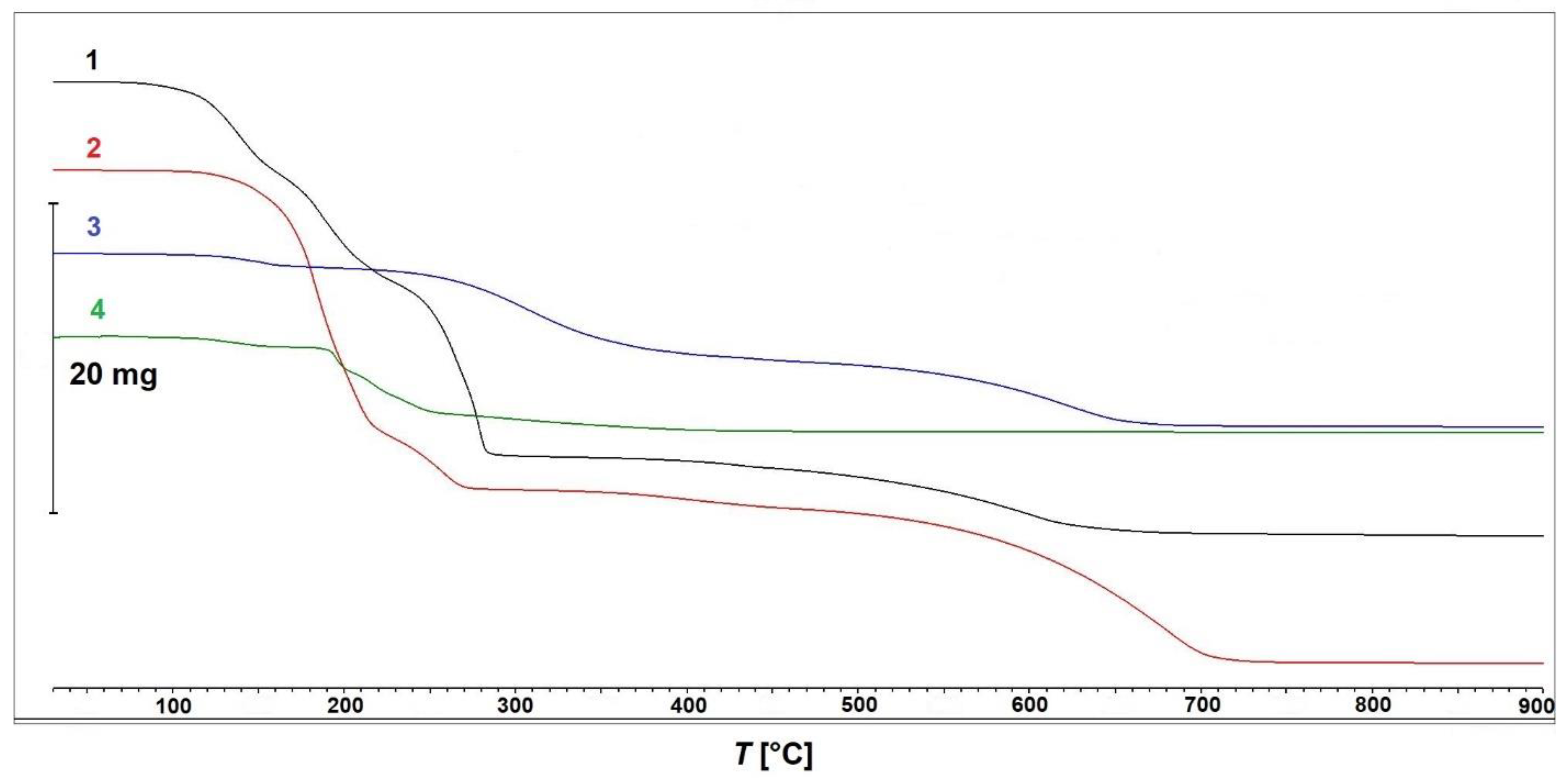
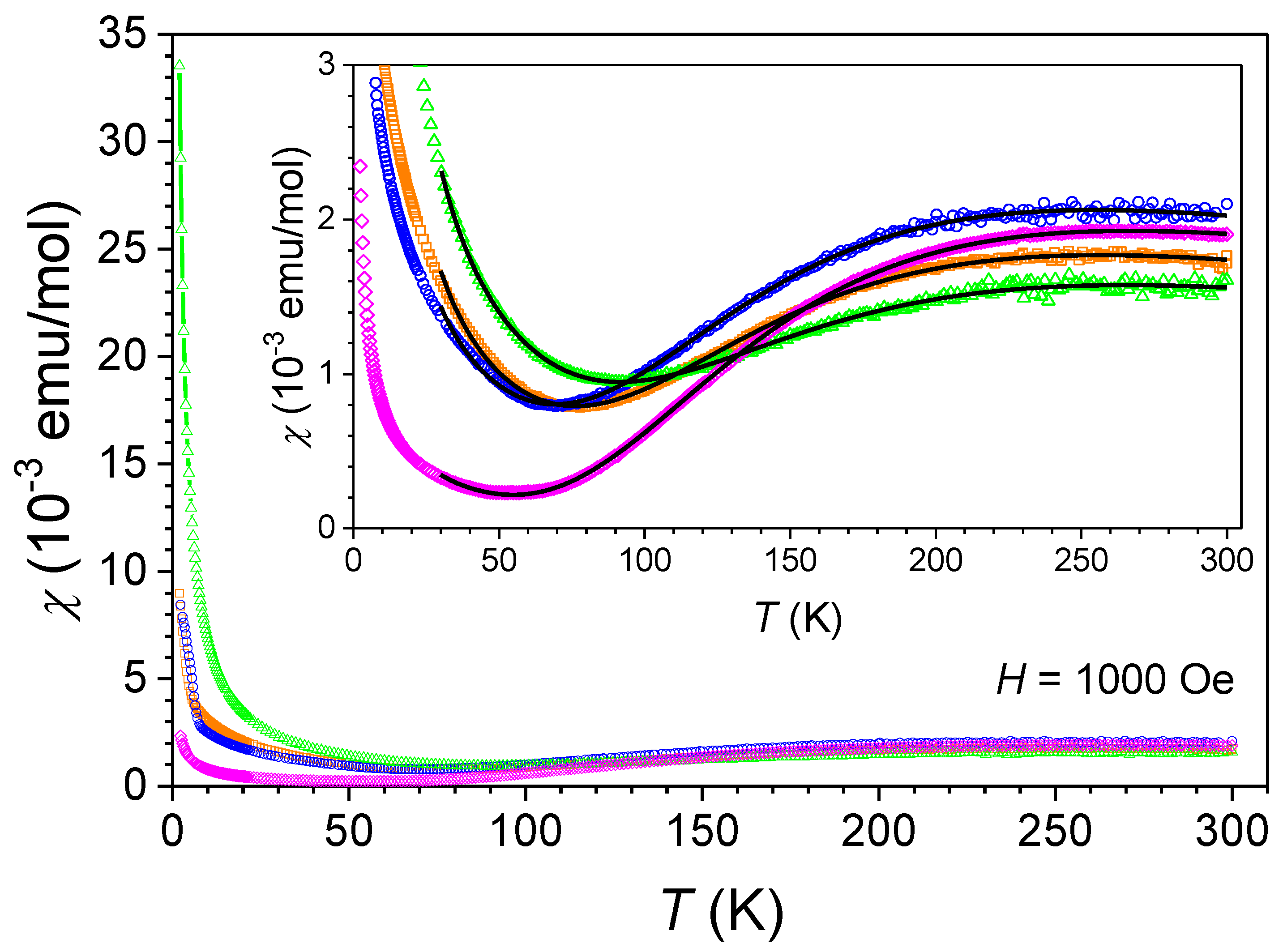
| 1 | 2 | 3 | 4 | |
|---|---|---|---|---|
| Formula | C12H40Cl4Cu2N4O10 | C12H28Cl2Cu2N2O8 | C16H48Cl4Cu2N4O10 | C28H80Cl5Cu2N5O12 |
| Mr | 669.38 | 526.36 | 725.46 | 983.32 |
| crystal system | monoclinic | monoclinic | triclinic | tetragonal |
| space group | P21/c, no.14 | P21/n, no.14 | P-1, no.2 | I-4, no.82 |
| a (Å) | 11.9035(10) | 7.8045(4) | 9.0370(6) | 17.4217(4) |
| b (Å) | 8.9511(7) | 11.9619(8) | 9.2174(6) | 17.4217(4) |
| c (Å) | 14.6769(14) | 11.0067(6) | 11.8008(7) | 7.8915(3) |
| α (°) | 90.00 | 90.00 | 99.455(5) | 90 |
| β (°) | 112.971(11) | 95.143(5) | 102.404(5) | 90 |
| γ (°) | 90.00 | 90.00 | 115.525(6) | 90 |
| V (Å3) | 1439.8(2) | 1023.41(10) | 828.73(10) | 2395.19(14) |
| Z | 2 | 2 | 1 | 2 |
| calc. density (g cm−3) | 1.544 | 1.708 | 1.454 | 1.363 |
| MoKα radiation (Å) | 0.71073 | 0.71073 | 0.71073 | 0.71073 |
| μ (mm−1) | 1.894 | 2.378 | 1.652 | 1.220 |
| crystal color and form | blue prism | blue prism | blue prism | blue prism |
| crystal dimensions | 0.15 × 0.15 × 0.40 | 0.12 × 0.23 × 0.27 | 0.25 × 0.35 × 0.35 | 0.07 × 0.07 × 0.16 |
| reflections measured | 7384 | 5517 | 7807 | 25,010 |
| θ range (°) | 2.7–30.2 | 3.5–29.9 | 2.6–30.3 | 2.8–30.3 |
| h, k, l range measured | −15→15; −12→12; | −11→7; −10→16; | −11→12; −12→11; | −23→24; −23→24; |
| −19→19 | −12→14 | −16→15 | −11→10 | |
| no. of independent refl. | 3740 | 2705 | 4291 | 3454 |
| Rint | 0.027 | 0.035 | 0.025 | 0.037 |
| observed r., F2 > 2σ(F2) | 3001 | 2324 | 3481 | 3196 |
| R[F2 > 2σ(F2)] | 0.030 | 0.030 | 0.033 | 0.023 |
| wR(F2), all data | 0.072 | 0.072 | 0.083 | 0.057 |
| goodness-of-fit, S | 0.990 | 1.062 | 1.068 | 1.081 |
| no. of contrib. reflect. | 3740 | 2705 | 4291 | 3454 |
| no. of parameters | 181 | 130 | 193 | 133 |
| Δρmax, Δρmin (eÅ−3) | 0.469, −0.512 | 0.453, −0.566 | 0.636, −0.540 | 0.283, −0.268 |
| 1 | |||
| Cu1—O1 | 1.9554 (13) | O4i—Cu1—O3 | 168.91 (6) |
| Cu1—O4i | 1.9685 (13) | O4i—Cu1—O2i | 87.24 (6) |
| Cu1—O3 | 1.9719 (13) | O3—Cu1—O2i | 89.41 (6) |
| Cu1—O2i | 1.9789 (13) | O1—Cu1—Cl1 | 98.60 (4) |
| Cu1—Cl1 | 2.4610 (5) | O4i—Cu1—Cl1 | 96.78 (4) |
| Cu1—Cu1i | 2.6033 (5) | O1—Cu1—O2i | 169.31 (6) |
| O1—Cu1—O4i | 91.85 (6) | O3—Cu1—Cl1 | 93.90 (5) |
| O1—Cu1—O3 | 89.49 (6) | O2i—Cu1—Cl1 | 92.08 (4) |
| (i) −x + 1, −y, −z + 1 | |||
| 2 | |||
| Cu1—O4i | 1.9707 (14) | O4i—Cu1—O3 | 167.36 (7) |
| Cu1—O3 | 1.9731 (14) | O4i—Cu1—O1 | 90.68 (6) |
| Cu1—O1 | 1.9800 (14) | O3—Cu1—O1 | 86.63 (6) |
| Cu1—O2i | 1.9825 (14) | O4i—Cu1—O2i | 88.60 (6) |
| Cu1—Cl1 | 2.4626 (6) | O3—Cu1—O2i | 91.33 (6) |
| Cu1—Cu1i | 2.6706 (5) | O1—Cu1—O2i | 167.30 (6) |
| O1—Cu1—Cl1 | 95.28 (5) | O4i—Cu1—Cl1 | 96.97 (5) |
| O2i—Cu1—Cl1 | 97.39 (5) | O3—Cu1—Cl1 | 95.57 (5) |
| (i) −x + 1, −y, −z + 1 | |||
| 3 | |||
| Cu1—O4i | 1.9663 (14) | O4i—Cu1—O3 | 168.30 (6) |
| Cu1—O3 | 1.9671 (14) | O4i—Cu1—O1 | 90.47 (6) |
| Cu1—O1 | 1.9711 (14) | O3—Cu1—O1 | 88.81 (6) |
| Cu1—O2i | 1.9783 (14) | O4i—Cu1—O2i | 87.93 (6) |
| Cu1—Cl1 | 2.4569 (6) | O3—Cu1—O2i | 90.40 (6) |
| Cu1—Cu1i | 2.6390 (5) | O1—Cu1—O2i | 168.22 (6) |
| O1—Cu1—Cl1 | 97.73 (5) | O4i—Cu1—Cl1 | 96.49 (5) |
| O2i—Cu1—Cl1 | 94.04 (5) | O3—Cu1—Cl1 | 95.17 (5) |
| (i) −x + 1, −y, −z + 1 | |||
| 4 | |||
| Cu1—O2i | 1.9647 (15) | O2i—Cu1—O2ii | 168.37 (9) |
| Cu1—O1iii | 1.9673 (15) | O2ii—Cu1—O1 | 89.13 (8) |
| Cu1—Cl1 | 2.6094 (3) | O2i—Cu1—Cl1 | 95.81 (4) |
| Cu1—Cu1ii | 2.6726 (6) | O2i—Cu1—O1 | 89.53 (8) |
| O1—Cu1—Cl1 | 96.62 (4) | O1iii—Cu1—O1 | 166.77 (9) |
| (i) −y + 1/2, x + 1/2, −z + 3/2; | (iii) −x, −y + 1, z; | (ii) y−1/2, −x + 1/2, −z + 3/2; |
| D-H···A | d(D-H) [Å] | d(H···A) [Å] | d(D···A) [Å] | <(DHA) [°] |
| 1 | ||||
| O1w-H2w1⋯Cl2i | 0.94(1) | 2.23(1) | 3.161(2) | 173(3) |
| O1w-H1w1⋯Cl2 | 0.93(1) | 2.27(1) | 3.179(2) | 166(2) |
| N1-H11⋯Cl2 | 0.94(3) | 2.24(3) | 3.166(2) | 168(2) |
| N1-H12⋯Cl2 | 0.83(3) | 2.41(3) | 3.172(2) | 154(2) |
| N1-H13⋯O4 | 0.90(3) | 2.46(3) | 3.090(2) | 127(2) |
| N1-H13⋯Cl1ii | 0.90(3) | 2.39(3) | 3.186(2) | 147(2) |
| N2-H21⋯O1w | 0.91(3) | 1.86(3) | 2.739(3) | 162(2) |
| N2-H22⋯Cl1iii | 0.91(3) | 2.57(3) | 3.381(2) | 149(3) |
| N2-H23⋯Cl1iv | 0.87(3) | 2.38(3) | 3.195(2) | 157(2) |
| (i) 2 − x, −1/2 + y, 3/2 − z; | (ii) 1 − x, −y, 1 − z; | (iii) 1 + x, 1/2 − y, 1/2 + z | (iv) 2 − x, −y, 1 − z | |
| 2 | ||||
| N1-H1⋯O1 | 0.79(3) | 2.28(3) | 2.962(3) | 145(2) |
| N1-H1⋯O3 | 0.79(3) | 2.45(3) | 3.120(3) | 144(2) |
| N1-H2⋯Cl1i | 0.90(3) | 2.29(3) | 3.140(2) | 159(2) |
| (i) 1/2 + x, 1/2 − y, 1/2 + z | ||||
| 3 | ||||
| O1w-H2w1⋯Cl2i | 0.86(4) | 2.34(4) | 3.207(2) | 176(3) |
| O1w-H1w1⋯Cl2 | 0.87(4) | 2.31(4) | 3.179(2) | 174(3) |
| N1-H11⋯O1w | 0.81(3) | 2.06(3) | 2.816(3) | 156(2) |
| N1-H12⋯Cl1 | 0.83(3) | 2.38(3) | 3.162(2) | 157(3) |
| N1-H12⋯O3 | 0.83(3) | 2.59(3) | 3.066(2) | 118(2) |
| N2-H21⋯Cl2 | 0.86(3) | 2.24(3) | 3.098(2) | 169(2) |
| N2-H22…O2 | 0.83(3) | 2.20(3) | 2.973(2) | 154(2) |
| N2-H22⋯Cl1ii | 0.83(3) | 2.80(3) | 3.325(2) | 123(2) |
| (i) −x, −y, −z; (ii) 1 − x, −y, 1 − z | ||||
| 4 | ||||
| O1w-H2w1⋯Cl2 | 0.97(1) | 2.09(1) | 3.055(2) | 175(3) |
| O1w-H1w1⋯O1wi | 0.95(1) | 1.88(2) | 2.780(3) | 158(3) |
| (i) y, 1 − x, 1 − z |
| Compound | Assignment | |||
|---|---|---|---|---|
| 1, cm−1 | 2, cm−1 | 3, cm−1 | 4, cm−1 | |
| 3443s, 3339s | 3437m, 3375m | 3444m, 3360m | νas(N–H) stretching νs(N–H) stretching | |
| 3037s, 3000s | 3073m, 3020m | 3010m, 2973m | 3011m, 2943m | ν(C–H) stretching |
| 1616s | 1615s | 1613s | ν(N–H) deformation | |
| 1603s, 1575s 1462s, 1435s | 1569s, 1540s 1463s, 1420s | 1594s, 1565s 1445s, 1416s | 1592s, 1568s 1439s, 1418s | νas(COO−) νs(COO−) |
| 155m, 1030m | 1053m, 1018s | 1060s, 1019s | 1049m, 1033s | ν(C–N) stretching |
| 956s, 940s | 940m | 938m | 955m | chlorates |
| 848m | 830m | 837m | ν(N–H) rocking | |
| 682s | 681s | 678s | 685s | ν(O–H) bending |
| Compound 1 | Compound 2 | Compound 3 | Compound 4 | |
|---|---|---|---|---|
| g | 2.21 | 2.30 | 2.14 | 2.34 |
| J | –221 K | –215 K | –239 K | –217 K |
| ρ | 5.4% | 4.0% | 8.2% | 1.0% |
Disclaimer/Publisher’s Note: The statements, opinions and data contained in all publications are solely those of the individual author(s) and contributor(s) and not of MDPI and/or the editor(s). MDPI and/or the editor(s) disclaim responsibility for any injury to people or property resulting from any ideas, methods, instructions or products referred to in the content. |
© 2024 by the authors. Licensee MDPI, Basel, Switzerland. This article is an open access article distributed under the terms and conditions of the Creative Commons Attribution (CC BY) license (https://creativecommons.org/licenses/by/4.0/).
Share and Cite
Golobič, A.; Dojer, B.; Jagodič, M.; Siher, A.; Pegan, A.; Kristl, M. Synthesis and Characterization of New Copper(II) Coordination Compounds with Methylammonium Cations. Inorganics 2024, 12, 261. https://doi.org/10.3390/inorganics12100261
Golobič A, Dojer B, Jagodič M, Siher A, Pegan A, Kristl M. Synthesis and Characterization of New Copper(II) Coordination Compounds with Methylammonium Cations. Inorganics. 2024; 12(10):261. https://doi.org/10.3390/inorganics12100261
Chicago/Turabian StyleGolobič, Amalija, Brina Dojer, Marko Jagodič, Anja Siher, Anže Pegan, and Matjaž Kristl. 2024. "Synthesis and Characterization of New Copper(II) Coordination Compounds with Methylammonium Cations" Inorganics 12, no. 10: 261. https://doi.org/10.3390/inorganics12100261







